The poem "The Bronze Horseman" is one of Pushkin's most capacious, mysterious and complex poems. He wrote it in the autumn of 1833 in the famous Boldin. This place and time gave extraordinary inspiration to Alexander Sergeyevich. The idea of Pushkin’s “Bronze Horseman” clearly resonates with the works of writers who lived much later and dedicated their creations, firstly, to the theme of Petersburg, and secondly, to the topic of the clash of a great sovereign idea and the interests of a “little man”. In the poem there are two heroes opposing each other and an insoluble conflict between them.
The Bronze Horseman: The History of the Poem
Pushkin worked intensively on the poem and finished it very quickly - in just twenty-five October days. In this fruitful period of his work, Alexander Sergeyevich also worked on The Queen of Spades, written by him in prose, and on the poetic story Angelo. The stunning “The Bronze Horseman” organically fit in here, the history of its creation is closely connected not only with realistic motifs and documents of the era, but also with the mythology that has developed around the great man and city that arose according to his highest will.
Censorship restrictions and controversy surrounding the poem
The Petersburg Story, as the author put it in its genre, was censored by Emperor Nicholas I himself, who returned the manuscript with nine pencil marks. The annoyed poet printed the text of the introduction to the poem “The Bronze Horseman” (the story of the creation of the poetic story is overshadowed by this fact) with eloquent voids in the place of tsar’s marks. Later, Pushkin nevertheless rewrote these places, but so that the meaning embedded in them did not change. Reluctantly, the emperor allowed the publication of the poem The Bronze Horseman. The story of the creation of the work is connected with the heated polemic that erupted around the poem after its publication.
The points of view of literary scholars
Disputes do not subside to this day. Traditionally, it is customary to talk about three groups of interpreters of the poem. The first includes researchers who claim the “state” aspect, which shines with the poem “The Bronze Horseman”. This group of literary critics, led by Vissarion Belinsky, put forward the version that Pushkin in his poem substantiated the right to commit cases crucial for the country, sacrificing the interests and life of a simple inconspicuous person.
Humanistic interpretation
Representatives of another group, led by the poet Valery Bryusov, Professor Makagonenko and other authors, completely sided with another character - Eugene, arguing that the death of even one of the most insignificant from the point of view of the sovereign idea of a person can not be justified by great accomplishments. This point of view is called humanistic. Many literary scholars are inclined to evaluate the story The Bronze Horseman, the history of the poem, the plot of which is based on the personal tragedy of a "small" person suffering from the results of a strong-willed decision by the authorities, a confirmation of this.
Eternal conflict
Representatives of the third group of researchers express a belief system about the tragic insolubility of this conflict. They believe that Pushkin gave an objective picture in the story "The Bronze Horseman." History itself judged the eternal conflict between the "miraculous builder" Peter the Great and the "poor" Eugene, an ordinary townsman with his modest demands and dreams. The two truths - the common man and the statesman - remain the same, and none are inferior to the other.
Terrible events and the poem "The Bronze Horseman"
The history of the creation of the poem, of course, fits firmly into the cultural and historical context of the time when it was created. Those were the times of disputes about the place of personality in history and the impact of the great transformations on the fates of ordinary people. This topic has worried Pushkin since the end of 1820. Based on documentary information about the flood that occurred in St. Petersburg on November 7, 1824, about which newspapers printed, the brilliant poet and thinker comes to major philosophical and social generalizations. The personality of the great and brilliant reformer Peter, who “put Russia on its hind legs” appears in the context of the personal tragedy of the insignificant official Eugene with his narrowly philistine dreams of his little happiness, not so unconditionally great and worthy of praise. The poem "The Bronze Horseman" by Pushkin is therefore not limited to the odic praise of the converter, which opened the "window to Europe."
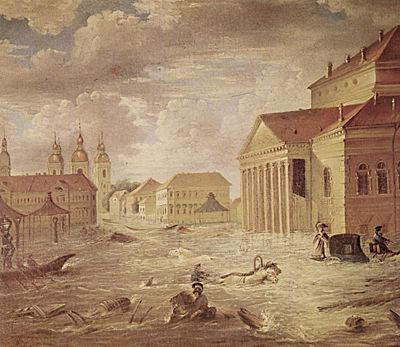
Contrast Petersburg
The northern capital arose thanks to the strong-willed decision of Tsar Peter the Great after the victory over the Swedes. Its foundation was intended to confirm this victory, to show the strength and power of Russia, as well as open the way for free cultural and commercial exchange with European countries. The city, in which the greatness of the human spirit was felt, manifested in a strict and harmonious architectural appearance, speaking the symbolism of sculptures and monuments, appears before us in the story "The Bronze Horseman". The history of the creation of St. Petersburg, however, is based not only on greatness. Built on the “swamp blat”, in which the bones of thousands of unknown builders lay, the city is enveloped in a sinister and mysterious atmosphere. Depressing poverty, high mortality, superiority in disease and the number of suicides - such is the other side of the magnificent crowned capital in the times of which Alexander Pushkin wrote. Two faces of the city, appearing one through the other, strengthen the mythological component of the poem. The "transparent dusk" of pale city lighting gives the inhabitants a feeling that they live in a mysterious and symbolic place in which monuments and statues can come to life and with an ominous determination. And with this, to a considerable degree, the history of the creation of the Bronze Horseman is also associated. Pushkin, as a poet, could not help but occupy such a transformation, which became the culmination of the plot. In the art space of the story, a cold bronze monument echoed echoing across a deserted pavement, pursuing a man maddened by grief after losing his beloved and collapsing all the hopes of Eugene.
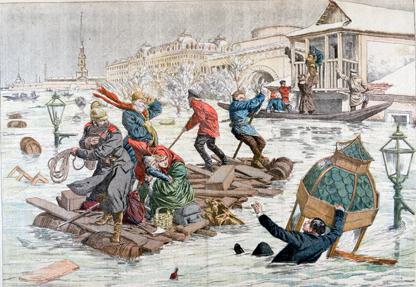
Entry idea
But before we hear the earth shudder under the hoof of an iron horse, we have to go through the sad and cruel events that happened in the life of the unfortunate Eugene, who blames the great Builder for setting up a city on lands subject to devastating floods, and also to realize the bright and the magnificent introduction that opens the poem The Bronze Horseman.
Peter is standing on the banks of a wild river, on the waves of which a fragile boat is swinging, and around are dense gloomy forests, in some places the miserable huts of the "Chukhontsev" stick out. But with his mind's eye, the founder of the northern capital already sees a “marvelous city”, ascended “proudly” and “magnificent” over the Neva, dressed in granite, a city associated with future state successes and great achievements. Pushkin does not name Peter - the emperor is mentioned here with the pronoun "he", and this emphasizes the ambiguity of the odic structure of the entry. Reflecting on how, someday, “resettlement” Russia will “threaten the Swede”, the great figure does not see today's “Finnish fisherman” who threw his “decrepit” net into the water. The sovereign is seeing the future, in which ships are directed to rich marinas from all over the world, but do not notice those who are sailing in a lonely boat and huddling in rare huts on the shore. When creating a state, the ruler forgets about those for whose sake it is created. And this painful discrepancy feeds the idea of the poem “The Bronze Horseman”. Pushkin, whose history was not just a collection of archival documents, but a bridge thrown into the present and future, especially acutely feels and expressively conveys this conflict.
Why was the bronze horseman copper in the mouth of the poet?
The point, of course, is not only that the 19th century writers did not see a significant semantic difference between bronze and copper. It is deeply symbolic that this is precisely the Bronze Horseman. The story of writing a poem in this case is combined with a biblical allegory. It is no coincidence that the poet refers to the statue of Peter as “the idol” and “idol” - the Bible authors say exactly the same words when speaking of the golden calves that the Jews worshiped instead of the Living God. Here the idol is not even gold, but just copper - this is how the author reduces the brilliance and grandeur of the image, sparkling with external dazzling luxury, but melting inside is by no means a precious content. Here are the implications of the story of the creation of the Bronze Horseman.
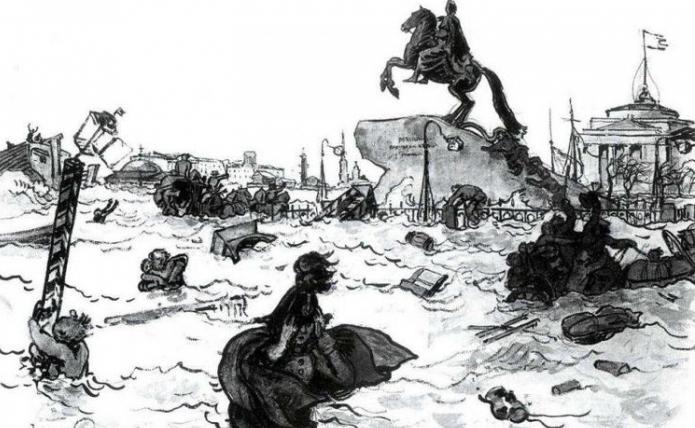
It is impossible to suspect Pushkin of unconditional sympathy for the sovereign idea. However, his attitude to the fictional idyll constructed in the dreams of Eugene is ambiguous. The hopes and plans of the "little man" are far from deep spiritual quests, and in this Pushkin sees their limitations.
The climax and denouement of the plot
After a colorful introduction and a declaration of love for the city, Pushkin warns that he will go on about the events of the “terrible”. A hundred years after what is happening on the shores of the Gulf of Finland, a St. Petersburg official, Eugene, returns home after service and dreams of his fiancee Parash. He is no longer destined to see her, since she, like her modest little house, will be taken away by the "frenzied" waters of the "infuriated" Neva. When the elements fall silent, Eugene will rush in search of his beloved and make sure that she is no longer alive. His consciousness cannot withstand the blow, and the young man goes crazy. He wanders around an unpleasant city, becomes a target for ridicule of the local guys, completely forgets the way home. In his troubles, Eugene blames Peter, who built the city in the wrong place and thereby put people in mortal danger. In despair, the madman threatens a bronze idol: “Oh, you! ..” Following that inflamed consciousness, he hears a heavy and sonorous “gallop” on the stones of the pavement and sees the Horseman rushing after him with his hand outstretched. After some time, Eugene is found dead at the threshold of his house and is buried. So the poem ends.
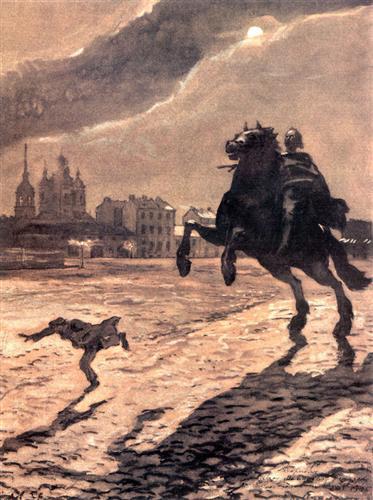
Element as a Full Hero
What role does the element play here, which is independent of human will and capable of destroying everything to the ground? Researchers of the story are convinced that, separating people, she connects the times with a certain metaphorical causal chain. She combined two plots of the story - external and internal - event and symbolic. The conflict of interests as if awakens the energy of the elements, which externally destroys fates and impedes human happiness. The resolution of this conflict lies in the fact that the gap between the greatness of sovereign designs and the spiritual space of the personality of a simple person was closed, closed. Such are the problems of Pushkin's The Bronze Horseman’s work, the history of the creation of the poem and the beginning of the mystical series of “Petersburg” novels and novels that the creators of the nineteenth and twentieth centuries will saturate with Russian literature.
Poem and monument
The unveiling of the monument to Peter the Great on Senate Square in St. Petersburg took place in late summer 1782. The monument, impressive with grace and grandeur, was erected by Catherine the Second. The French sculptors Etienne Falcone, Marie Ann Collot and the Russian master Fedor Gordeev worked on the creation of the equestrian statue, sculpting a bronze snake under the frenzied hoof of Petrov’s horse. A monolith called a thunder-stone was installed at the foot of the statue, its weight was a little less than two and a half tons (the entire monument weighs about 22 tons). From the place where the block was discovered and found suitable for the monument, the stone was carefully transported for about four months.
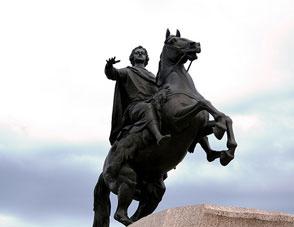
After the publication of the poem of Alexander Pushkin, the hero of which the poet made this monument, the sculpture was called the Bronze Horseman. Residents and visitors of St. Petersburg have a great opportunity to see this monument, which, without exaggeration, can be called the symbol of the city, almost in a pristine architectural ensemble.